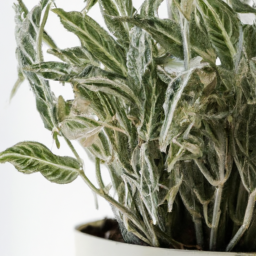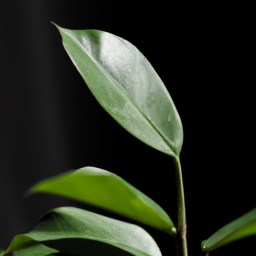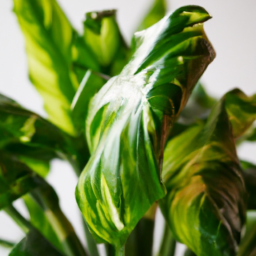
Are you looking to bring some greenery into your home but don’t have a lot of natural light? No worries – there are plenty of indoor plants that thrive in low light conditions! In this blog post, we’ll explore some of the best options for Indoor Plants for Low Light and how you can care for them to keep them healthy and thriving in your home. Whether you have a dark corner that needs brightening up or just want to add some greenery to your space, these plants are sure to bring life and beauty to any room. So let’s dive in and discover the perfect low-light plants for your home!
Benefits of Indoor Plants for Low Light Environments
Improved Air Quality
Indoor plants are not only aesthetically pleasing but also serve a practical purpose by improving air quality. In low light environments, certain plants can still thrive and help purify the air by removing toxins and releasing oxygen. Plants such as pothos, spider plants, and peace lilies are known for their air-purifying properties and can thrive in low light conditions. By having these plants in your home or office, you can breathe easier and enjoy cleaner air.
In addition to removing toxins from the air, indoor plants can also help regulate humidity levels. This is especially beneficial in low light environments where the air may feel stagnant and dry. Plants release moisture through a process called transpiration, which can help increase humidity levels and create a more comfortable indoor environment. By incorporating indoor plants into your space, you can improve air quality and create a healthier living or working environment.
Furthermore, indoor plants have been shown to reduce stress and improve overall well-being. Studies have found that being around plants can have a calming effect on individuals and help reduce feelings of anxiety and fatigue. In low light environments where natural light may be limited, having plants around can help create a more relaxing and inviting space. By adding indoor plants to your interior design, you can enhance both the aesthetic appeal and the overall atmosphere of your space.
Enhanced Aesthetic Appeal
Indoor plants are a great way to add a touch of nature to any indoor space, even in low light environments. Plants can help create a sense of tranquility and bring life to dull or dark areas. In low light conditions, it is important to choose plants that are well-suited to these environments and can thrive without direct sunlight. Plants such as snake plants, ZZ plants, and philodendrons are excellent choices for low light spaces and can add a pop of greenery to any room.
In addition to their aesthetic appeal, indoor plants can also serve as natural decor elements that enhance the overall look and feel of a space. Plants come in a variety of shapes, sizes, and textures, making them versatile design elements that can complement any style or theme. Whether you prefer a minimalist aesthetic or a bohemian vibe, there are indoor plants that can suit your taste and enhance the visual appeal of your space.
Moreover, indoor plants can be used to create focal points or accentuate specific areas within a room. By strategically placing plants in key locations, you can draw attention to certain features or create visual interest in an otherwise bland space. Plants can also be used to soften harsh lines or add a touch of warmth to a room. In low light environments, incorporating plants into your decor can help brighten up the space and make it feel more inviting.
Easy Maintenance
One of the benefits of indoor plants for low light environments is their ease of maintenance. In low light conditions, it is important to choose plants that are resilient and can thrive with minimal sunlight. Fortunately, there are many indoor plants that are well-suited to low light environments and require little care. Plants such as pothos, snake plants, and spider plants are known for their hardiness and can tolerate low light conditions.
Indoor plants for low light environments typically require less frequent watering and can go longer periods between waterings. This makes them ideal for busy individuals or those who may not have a green thumb. In addition, low light plants are generally less prone to pests and diseases, making them easier to care for and maintain. By choosing plants that are well-suited to low light conditions, you can enjoy the benefits of indoor plants without the hassle of constant upkeep.
Furthermore, indoor plants can be a cost-effective way to enhance your space and improve air quality. Many low light plants are affordable and readily available at nurseries or garden centers. By investing in a few indoor plants, you can transform your space and create a healthier, more inviting environment. With minimal effort and maintenance, indoor plants can bring a touch of nature into your home or office and provide a range of benefits for your well-being.

Top 10 Indoor Plants That Thrive in Low Light Conditions
Are you looking to add some greenery to your indoor space but don’t have a lot of natural light? Not to worry! There are plenty of indoor plants that can thrive in low light conditions. In this guide, we will explore the top 10 indoor plants that are perfect for low light environments. These plants are not only easy to care for but also add a touch of nature to your home or office.
1. Snake Plant
The Snake Plant, also known as Mother-in-Law’s Tongue, is a popular choice for low light spaces. This plant is extremely hardy and can survive in almost any lighting conditions. It requires minimal watering and can go for weeks without attention. The Snake Plant is also known for its air-purifying qualities, making it a great addition to any indoor space.
When caring for a Snake Plant in low light, make sure to place it near a window where it can still receive some indirect sunlight. Water the plant sparingly, allowing the soil to dry out completely between waterings. With minimal care, the Snake Plant will thrive and add a touch of green to your space.
Overall, the Snake Plant is a great choice for beginners or those with busy schedules. Its low maintenance requirements and adaptability to low light make it a top choice for indoor spaces.
2. Peace Lily
The Peace Lily is another popular indoor plant that thrives in low light conditions. This plant is known for its beautiful white flowers and glossy green leaves. The Peace Lily is a great air purifier and can help improve the air quality in your home or office.
When caring for a Peace Lily in low light, it is important to keep the soil consistently moist but not waterlogged. Place the plant in a spot where it can receive indirect sunlight, such as near a window with sheer curtains. The Peace Lily will reward you with beautiful blooms and lush foliage with minimal effort.
Overall, the Peace Lily is a stunning addition to any indoor space and is perfect for those looking for a low maintenance plant that thrives in low light conditions.
3. Spider Plant
The Spider Plant is a classic choice for indoor spaces with low light. This plant is known for its long, arching leaves and spider-like plantlets that dangle from the main plant. The Spider Plant is easy to care for and can thrive in a variety of lighting conditions.
When caring for a Spider Plant in low light, make sure to water it regularly and keep the soil evenly moist. Place the plant in a spot where it can receive indirect sunlight, such as near a north-facing window. The Spider Plant will thrive in low light conditions and add a touch of green to your space.
Overall, the Spider Plant is a versatile and easy-to-care-for plant that is perfect for beginners or those with limited natural light. Its unique appearance and air-purifying qualities make it a top choice for indoor spaces.

Tips for Caring for Indoor Plants in Low Light Settings
Understanding Low Light Conditions
When it comes to caring for indoor plants in low light settings, it’s important to understand what exactly constitutes low light conditions. Low light typically refers to areas in your home that receive minimal natural light, such as rooms with small windows or spaces that are far from any windows. While most plants thrive in bright, indirect light, there are certain varieties that can tolerate and even thrive in low light environments.
Plants that are well-suited for low light conditions are typically those that originate from the forest floor, where they are used to receiving filtered sunlight through the canopy above. These plants have adapted to thrive in low light by being able to efficiently photosynthesize with minimal light exposure. Some common examples of low light plants include pothos, snake plants, and peace lilies.
When placing your indoor plants in low light settings, it’s important to consider the direction of the light source. While these plants can survive in low light, they still need some level of light exposure to thrive. Make sure to rotate your plants every few weeks to ensure that all parts of the plant receive adequate light.
Caring for Low Light Indoor Plants
One of the most important aspects of caring for indoor plants in low light settings is to avoid overwatering. With lower light levels, plants will not be able to dry out as quickly as they would in brighter conditions. This means that they are more susceptible to root rot if they are sitting in waterlogged soil. Make sure to allow the top inch of soil to dry out before watering your plants, and always use pots with drainage holes to prevent water from pooling at the bottom.
In addition to proper watering, it’s also important to regularly dust the leaves of your indoor plants. Dust can accumulate on the leaves, blocking sunlight from reaching the plant’s cells and inhibiting photosynthesis. Simply wipe down the leaves with a damp cloth every few weeks to keep them clean and healthy.
Another key aspect of caring for indoor plants in low light settings is to avoid fertilizing them too frequently. With lower light levels, plants will not be able to utilize the nutrients in the soil as quickly as they would in brighter conditions. Fertilize your plants sparingly, using a diluted, balanced fertilizer every 4-6 weeks during the growing season.
Choosing the Right Plants for Low Light
When selecting indoor plants for low light settings, it’s important to choose varieties that are well-suited for these conditions. Some plants that are known for their ability to thrive in low light include the cast iron plant, spider plant, and ZZ plant. These plants are all relatively low maintenance and can tolerate long periods of low light without issue.
If you’re looking to add a pop of color to your low light space, consider plants like the pothos, peace lily, or Chinese evergreen. These plants are not only beautiful but also relatively easy to care for in low light conditions. Just make sure to place them near a window or another light source to ensure they receive enough light to thrive.
Overall, caring for indoor plants in low light settings requires a bit of extra attention and care, but with the right plants and proper maintenance, you can create a lush and thriving indoor garden in even the darkest corners of your home. Remember to water sparingly, dust regularly, and choose the right plants for your space to ensure success.
Key Takeaways of this article
If you’re struggling to keep your indoor plants alive because your home doesn’t get a lot of natural light, don’t worry – there are plenty of options for low-light plants that can thrive in dimmer conditions. Some popular choices include pothos, snake plants, and peace lilies, all of which are known for their ability to thrive in low light environments. These plants are not only easy to care for, but they also help purify the air in your home, making them a great addition to any space.
When choosing indoor plants for low light, it’s important to consider the specific conditions of your home. Some plants may require a bit more light than others, so it’s important to do your research before making a decision. Additionally, make sure to water your plants appropriately and avoid overwatering, as this can lead to root rot. With a little bit of care and attention, you can enjoy the beauty of indoor plants even in low light conditions.
Here are the top questions that we were asked:
Q1. What are some indoor plants that thrive in low light conditions?
A1. Some indoor plants that do well in low light conditions include snake plants, pothos, peace lilies, spider plants, and ZZ plants. These plants are great options for areas of your home that receive minimal natural light.
Q2. How often should I water indoor plants that are in low light areas?
A2. It’s important to be mindful of overwatering plants in low light conditions since they may not dry out as quickly. Check the soil moisture before watering and aim to water only when the top inch of soil is dry. Generally, indoor plants in low light may require water less frequently compared to plants in brighter light.
Q3. Do indoor plants in low light conditions still need sunlight?
A3. While indoor plants in low light conditions can survive without direct sunlight, they still benefit from some exposure to natural light. Try to rotate your plants occasionally or place them near a window where they can receive indirect sunlight to help them thrive.
Q4. How can I improve the growth of indoor plants in low light?
A4. To promote the growth of indoor plants in low light, you can supplement with artificial grow lights specifically designed for plants. Additionally, consider using reflective surfaces to help bounce light towards your plants and keep their leaves clean to maximize light absorption.
Q5. Are there any indoor plants that can survive in completely dark rooms?
A5. While most plants require some amount of light to survive, there are a few low light tolerant options that can manage in very dim conditions. Some examples include cast iron plants, Chinese evergreens, and parlor palms. Keep in mind that these plants may grow slower or show less vibrant foliage in completely dark rooms.

James Wong is a renowned ethnobotanist, plant scientist, and local television presenter. With a passion for demystifying plant science, he is known for translating complex botanical concepts into practical advice for everyday plant enthusiasts. James’s expertise spans from traditional gardening to cutting-edge plant technologies, making his insights accessible and informative.


